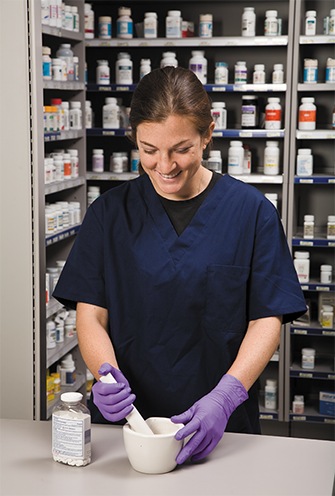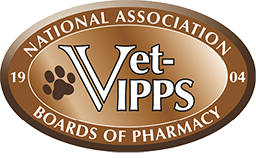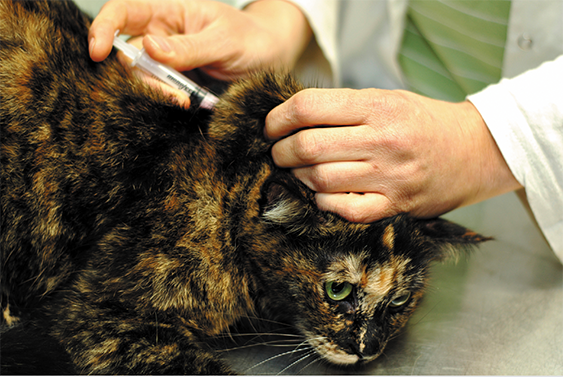10.1 Types of Compounding
Compounding is, as they say, both an art and a skill. It is defined as the process in which a pharmacist or a technician uses bulk ingredients to prepare a prescribed medication that treats a specific patient’s medical condition. It involves preparing, mixing, assembling, altering, packaging, and labeling a prescription according to a formulated recipe and prescription by a licensed prescriber who individualizes the appropriate quantity and dosage form for the patient. This can include steps of reconstituting, diluting, concentrating, flavoring, or changing a dosage form. However, if one is just reconstituting, diluting, or flavoring a manufactured medication according to the directions on the product package insert or labeling, this is not compounding. It is merely following product-specific dispensing directions.
 Pharm Fact
Pharm Fact
Simply following manufacturers’ directions for reconstituting, flavoring, or diluting is not compounding. It is only considered compounding in the United States when preparations are made for products not available from manufacturers in the needed form, dosage, concentration, or other integral characteristic.
For instance, mixing a powdered antibiotic according to the manufacturer’s directions with a compatible diluent such as distilled water to make an oral suspension (or adding the recommended flavoring) is not considered compounding. But if you reconstitute a medication and then put it into a different dose or dosage formulation than the usual, or combine it with another medication in an individualized way, this is compounding.
Compounding is getting off the beaten path of dispensing the manufactured products to creating something more individualized that is not available on the market. In the most complex compounding, it is not just a skill but an art, where the pharmacist has to interpret the best way to individualize an established formula to fit the prescriber’s unique instructions for the patient. The specially trained technician becomes an assistant in this artful application of tailored medication creation.
Sterile Compounding
Sterile compounding uses aseptic technique to prepare solutions free of microorganisms for parenteral products or ophthalmic preparations. Sterile compounding is performed in a cleanroom environment. These are found in hospitals and in home care infusion and nuclear pharmacies as well as in specialty compounding facilities. Sterile compounding must be performed under strictly controlled environmental conditions to minimize the risk of contamination of the compounded sterile preparations (CSPs). The guidelines for sterile compounding—including a cleanroom environment, correct aseptic technique, and specialized equipment and training—are discussed in Chapters 12 and 13.
Nonsterile Compounding
Though not prepared in as controlled an environment as sterile compounding, nonsterile compounding follows particular guidelines to keep medications as contamination-free as possible within a sanitized compounding space in a community or compounding pharmacy. These guidelines are found in United States Pharmacopeial Convention (USP) General Chapter <795>. Since the drug formulations (such as capsules, tablets, ointments, creams, solutions, suspensions, powders, and suppositories) are not injected directly into a vein, aseptic technique and sterility are not required, but drug safety, stability, and integrity remain important concerns.
 Put Down Roots
Put Down Roots
Extemporaneous comes from the Latin ex tempore, meaning “out of the time,” or coming from the time. So it means compounding for an immediate need made for the occasion.
Current laws require that nonsterile compounding occurs only for medications, dosages, and forms that are not commercially available. When compounding occurs for a specific need of the moment for a particular patient, it is known as extemporaneous compounding. This is the majority of nonsterile compounding in a community pharmacy. Common compounding prescription requests include creating an oral suspension from crushed tablets or a topical ointment from a drug administered by a different route, or mixing two solutions for an ear drop. Medical specialists (especially dermatologists and gynecologists) and dentists often prefer to individualize their prescriptions for their patients. Physicians from hospice care for the terminally ill and pain management clinics often use the services of a compounding pharmacy to meet patients’ specific pain needs.
 Practice Tip
Practice Tip
Compounding uses more individualized instructions and calculations than the manufacturer’s general directions.

Compounding, or the art of pharmacy, involves combining patient-specific medications.
Nonsterile compounding comes in three levels of complexity:
Simple—reconstituting and recombining commercial products following USP monograph directions or peer-reviewed articles with specific quantities, common formularies, or a manufacturer’s guidelines established and requiring no unknown calculations
Moderate—requiring some special calculations
Complex—requiring special calculations, decision making, training, procedures, equipment, and environment
To gain a better understanding of the circumstances in which nonsterile compounding is performed in the pharmacy setting, here are some possible scenarios:
For a young, underweight child, a prescriber orders a medication dose smaller than any dose commercially available. For example, the prescription calls for 10 mg per dose of a medication available only in 30 mg unscored tablets. The technician (under pharmacist supervision) may pulverize the tablets and then mix the powder with an inactive powder to fill capsules containing the weight equivalent to 10 mg of the active medication.
A medication typically available in a solid dosage form is prescribed in another dosage form—such as a liquid, suspension, or suppository—for administration to patients who cannot or will not swallow the solid form or are experiencing severe nausea. The tablets may need to be triturated using a mortar and pestle and then the powder added to a suitable suspending agent.
A prescriber requests a commercially available dose or dosage form that is no longer available due to a drug shortage or back order, so it must be specially prepared.
To ensure that a child will take an oral medication (currently in a tablet or capsule form) usually dosed for adults that has an unpleasant bitter taste, it must be prepared first in a child’s dosage amount and then compounded in a syrup vehicle with a more palatable, flavor-masking base.
A topical gel formulation must be prepared for a patient whose oral medication has had adverse effects on the stomach (such as causing ulcers).
A patient has allergies to a commercial medication’s preservatives, colorings, or other ingredients, so an alternative without the unwanted ingredients needs to be prepared.
To reduce side effects, a postmenopausal woman may have the need for a hormone replacement therapy formulation besides the commercially available fixed-dose tablets. A compounded mixture of hormones in a cream or gel formulation can be individualized to relieve the patient’s symptoms and minimize side effects.
Many drugs used in humans can also be used to treat other animals in different dosages and forms. Veterinarians frequently require the compounding expertise of pharmacies to fulfill the unique medication requirements of the animals in their care, such as a thyroid medication for a cat or seizure medications for a dog.
 Safety Alert
Safety Alert
Products compounded for veterinary use cannot be used in humans.
That is why many community pharmacies receive a portion of their business from veterinary referrals. Nonsterile compounding allows medications to be catered to an animal’s species and size. Technicians need to be aware of the rules of the American Veterinary Medical Association (AVMA), as spelled out in its “Guidelines for Veterinary Prescription Drugs” at https://PharmPractice7e.ParadigmEducation.com/AVMA. The medications must be compounded from FDA-approved animal or human drugs. The AVMA assumes that the compounding pharmacy follows all USP Chapter <795> guidelines and is accredited. If the pharmacy is online, it should apply for the National Association of Boards of Pharmacy’s Veterinary-Verified Internet Pharmacy Practice Sites accreditation.

Online pharmacies that compound animal medications require verification in much the same way as pharmacies that compound human medication.

Compounding pharmacies often prepare a drug originally manufactured for humans in a special formulation for a pet.